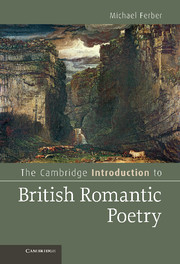Book contents
- Frontmatter
- Contents
- Preface
- Acknowledgments
- Chapter 1 Introduction
- Chapter 2 The poet
- Chapter 3 “Tintern Abbey”
- Chapter 4 Romantic odes
- Chapter 5 The French Revolution
- Chapter 6 Romantic sonnets
- Chapter 7 Romantic love lyrics
- Chapter 8 Romantic ballads
- Chapter 9 Romantic epics and romances
- Chapter 10 Romantic verse drama
- Chapter 11 Romantic satire
- Appendix
- Notes
- Further reading
- Index
Chapter 1 - Introduction
Published online by Cambridge University Press: 05 June 2012
- Frontmatter
- Contents
- Preface
- Acknowledgments
- Chapter 1 Introduction
- Chapter 2 The poet
- Chapter 3 “Tintern Abbey”
- Chapter 4 Romantic odes
- Chapter 5 The French Revolution
- Chapter 6 Romantic sonnets
- Chapter 7 Romantic love lyrics
- Chapter 8 Romantic ballads
- Chapter 9 Romantic epics and romances
- Chapter 10 Romantic verse drama
- Chapter 11 Romantic satire
- Appendix
- Notes
- Further reading
- Index
Summary
This is a book about Romantic poetry written in Britain from the 1780s to the 1830s. By the middle of this period many readers of poetry, and many poets themselves, felt that theirs was a time when poetry had grown great again, comparable to the age of Shakespeare and Spenser two centuries earlier. As Keats stated it in the opening line of one of his sonnets (1817), “Great spirits now on earth are sojourning.” Today, after two more centuries, most of those who care about poetry would agree. The most often anthologized poem in English, William Blake’s “The Tyger,” comes from this time (1794), and so do many of the most often quoted poetic passages: “Water, water, every where, / Nor any drop to drink”; “I wandered lonely as a cloud”; “O my luve’s like a red, red rose”; “She walks in beauty, like the night / Of cloudless climes and starry skies”; “Hail to thee, blithe spirit”; “Beauty is truth, truth beauty.” To some it feels as if poetry is Romantic poetry, while the prevalent caricature of “the poet” today is of someone impractical, bohemian, otherworldly, visionary, and young, that is, a “Romantic.”
- Type
- Chapter
- Information
- Publisher: Cambridge University PressPrint publication year: 2012
- 1
- Cited by

